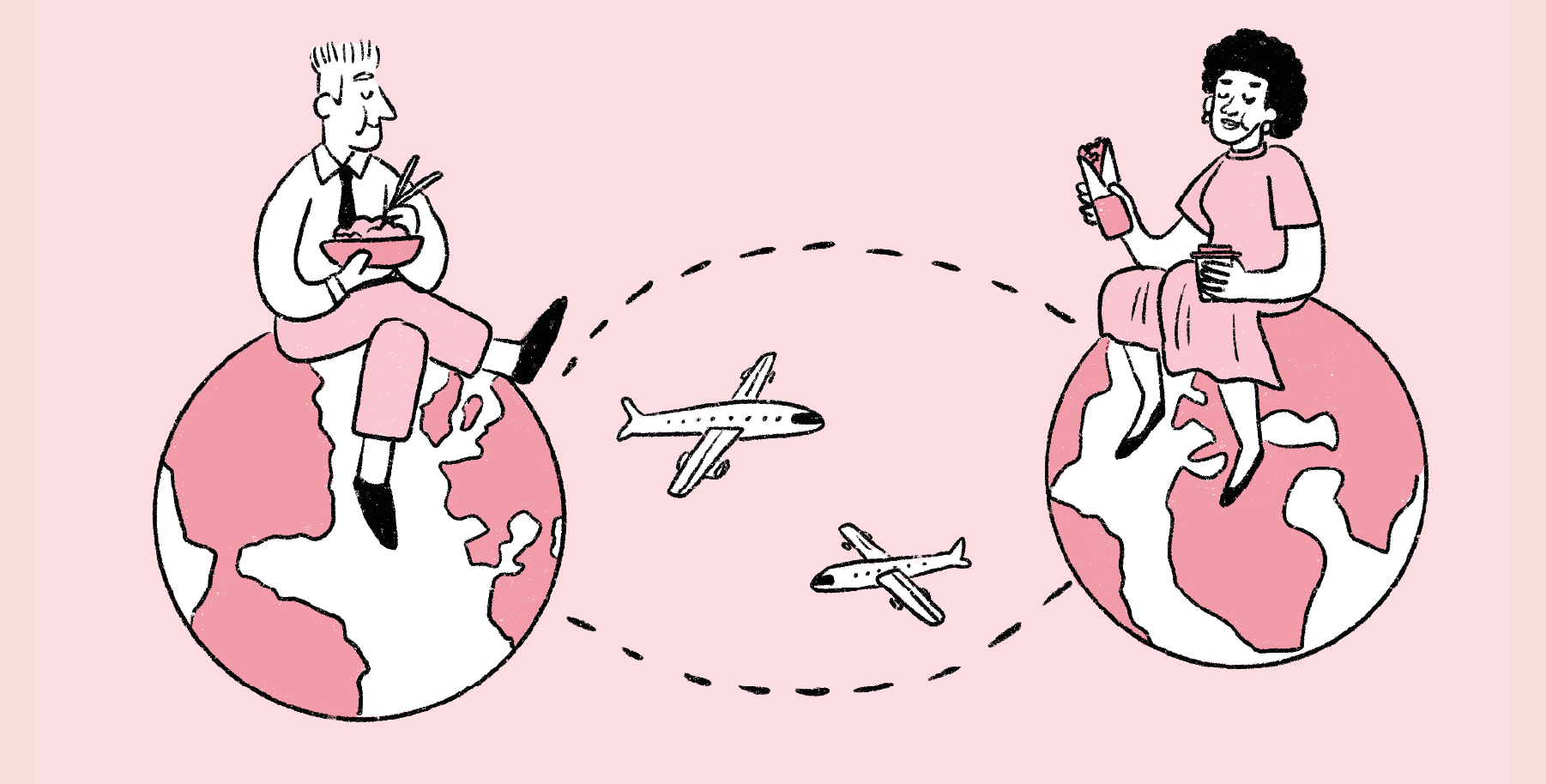A guide to UK per-diem: HMRC meal allowance rates for 2024


Annual business travel costs skyrocketed worldwide in 2022 when the world opened up post-Covid, yet 2024’s spend is set to exceed pre-pandemic levels . While we’re all relieved to see life return to normal, this consistent growth in business trips will mean a whole lot of extra expenses to track and account for.
Your employees might love travelling for work, but they probably don’t love all the paperwork that comes with filing expense claims. Between public transport, accommodation and mileage costs, expense submissions can feel like a huge waste of time (and a bummer on what’s supposed to be a work perk).
Luckily, one aspect of the expenses process is made a whole lot easier through HMRC subsistence rates for 2024. This meal allowance works in conjunction with other expenses associated with business trips. It simplifies expense claims, making life for both your finance team and travelling employees much easier.
Not familiar with how HMRC meal allowance works? Let us walk you through it.
What is a meal allowance?

Through the standard HMRC subsistence allowance, the government sets a rate for a blanket expense reimbursement for all employed people. This is the suggested amount that employees will be given, or reimbursed, for meals while travelling for work .
It even goes as far as suggesting different rates for different locations, including international destinations and overnight rates. Businesses are even allowed to backdate their claims for up to five years, so if your company has been using a digital expense solution like Pleo, you can look back at your receipts and claim the full tax relief. Phew!
And good news for all your freelancers – self-employed people also have access to their own meal allowance rates through a separate HMRC scheme.
It’s important to note that your company doesn’t have to follow these guidelines – they actually don’t have to reimburse staff meals at all. But it’s a good way to thank employees who travel away from their regular workplace, whether it be meeting clients, attending conferences or visiting different offices.
As well as a nice employee benefit, the meal allowance also has favourable tax perks for companies. But more on that later …
Why is the food allowance important?
The subsistence payment is important as it benefits both the employee and the company.
In fact, the company-side benefits for HMRC meal allowance go way beyond just tax relief.
It makes budgeting a whole lot easier, since set amounts have no variability. With events and meetings planned in advance, your finance team can create a budget around spending even while working from home (including travel and accommodation, too).
Plus, they can use this to inform their reporting in real-time. This way finance can avoid delays that are likely to affect to other accounting processes, meaning your people can spend less time on the tedious tasks and more time working on growth .
What’s more, the finance department doesn’t have to wait until after the trip to fill out monthly spending reports and determine profits, expenses or taxes as the meal allowance determines the exact cost. This way, it can be done in advance – simple as that.
For employees, the benefit means more choice. Pasta? Sushi? Kebab? The choices are endless!

So, HMRC subsistence rates reduce the need to submit expense claims, which means less paperwork on both sides. Sign me up!
What are domestic scale rate payments?
Let’s get to the part you really want to know: the rates themselves.
When qualifying conditions are met, the food allowance that HMRC scale-rates depends on either the length of time an employee has travelled, or the distance they must travel from their regular workplace.
HMRC's definition of a “meal” is simply a combination of food and drink items, just like in the dictionary.
Here are HMRC daily subsistence allowance rates for work-related travel inside of the UK:
|
Minimum journey time |
Maximum meal allowance |
|---|---|
|
One meal (5 hours) |
£5 |
|
Two meals (10 hours) |
£10 |
|
When working after 8pm |
£15 |
|
24-hour period |
£25 max. |
The maximum allowance of £25 in any 24 hour period refers to all meals being taken (£5 + £5 + £15), as the max allowance for evening meals would remain at £15.
When do HMRC per-diem rates apply?
As mentioned, there are a set of very specific conditions for the subsistence expense. In order to use HMRC approved subsistence rates, all of these conditions must be met:
- Travel should be for the purpose of work or to a temporary workplace outside the ordinary commuting journey
- Your employees should be absent from the usual workplace (whether that’s an office, permanent client site or home) for a continuous period of at least 5 or 10 hours
- The meal was bought and eaten after the journey began and the member of staff has kept appropriate evidence, such as a receipt
- If staying with friends or family while on business trips, employees can also claim a £42 per night flat rate allowance.
For international travel, a different set of per-diem scale rates apply.
International meal allowance rates

HMRC subsistence allowance applies to overseas travel for the purpose of work and is also available for backdating through expense reconciliation.
While the meal allowance for UK employees is a blanket rate, separate countries have a different per-diem allowance. Remember that each location uses its local currency, so the rate in British pounds will fluctuate with exchange rates.
Since a normal working day lasts between five and ten hours, here are some examples of the daily meal allowance in various countries (in that country’s currency):
|
Country |
City |
One meal |
Two meals |
Overnight (+ room rate) |
|---|---|---|---|---|
|
Australia |
Brisbane |
49.50 |
128.50 |
156.50 |
|
Austria |
Vienna |
33 |
84 |
89.50 |
|
Belgium |
Brussels |
27 |
71 |
76 |
|
Brazil |
Brasilia |
61 |
155 |
177.50 |
|
Canada |
Vancouver |
38.50 |
84.50 |
114.50 |
|
China |
Beijing |
232 |
563 |
605.50 |
|
Colombia |
Bogota |
49,827 |
118,240.50 |
140,054 |
|
Denmark |
Copenhagen |
235 |
683 |
895.50 |
|
Dominican Republic |
Santo Domingo |
1,048.50 |
2,402.50 |
2,846 |
|
Ecuador |
Quito |
29 |
67.50 |
105 |
|
Egypt |
Cairo |
279 |
702 |
761 |
|
Finland |
Helsinki |
33 |
75.50 |
82 |
|
France |
Bordeaux |
44 |
114 |
135 |
|
Germany |
Berlin |
22 |
65.50 73 |
72 79.50 |
|
Greece |
Athens |
28.50 |
62.50 |
67.50 |
|
Hong Kong |
Hong Kong |
292.50 |
761.50 |
816.50 |
|
Hungary |
Budapest |
6,092 |
14,512.50 |
16,001 |
|
India |
Mumbai |
2,186 |
4,567.50 |
5,108 |
|
Ireland |
Dublin |
38.50 |
94 |
99 |
|
Italy |
Venice |
34 |
84.50 |
96.50 |
|
Japan |
Tokyo |
4,445.50 |
10,534.50 |
11,290.50 |
|
Republic of Korea |
Seoul |
64,949 |
147,488 |
167,991 |
|
Luxembourg |
Luxembourg |
33 |
89 |
123 |
|
Mexico |
Mexico City |
223.50 |
648 |
1,034.50 |
|
Morocco |
Fes |
178 |
502 |
553.50 |
|
Netherlands |
Amsterdam |
25 |
65 |
72 |
|
Norway |
Oslo |
326 |
806.50 |
848 |
|
Philippines |
Manila |
1,528.50 |
3,751 |
4,345 |
|
Poland |
Warsaw |
154 |
372.50 |
393 |
|
Portugal |
Lisbon |
25.50 |
69.50 |
74.50 |
|
Qatar |
Doha |
227 |
524.50 |
617.50 |
|
Romania |
Bucharest |
96 |
218.50 |
243 |
|
Russia |
Moscow |
1,878.50 |
4,567.50 |
5,313 |
|
Singapore |
Singapore |
91.50 |
206.50 |
218 |
|
Spain |
Barcelona |
28 |
76 |
101.50 |
|
Sweden |
Stockholm |
379 |
857.50 |
917.50 |
|
Switzerland |
Berne |
47 |
109.50 |
118 |
|
Taiwan |
Taipei |
1,673 |
3,982 |
4,210.50 |
|
Thailand |
Bangkok |
1,048 |
2,565.50 |
2,965 |
|
United Arab Emirates |
Abu Dhabi |
98 |
242.50 |
373.50 |
|
United States of America |
Boston |
32 |
76.50 |
97.50 |
|
Vietnam |
Hanoi |
18 |
74 |
85.50 |
|
Zimbabwe |
Harare |
31.50 |
68.50 |
92.50 |
If you want to see more countries’ international per-diem rates, the full list is available right here .
What happens if you go over HMRC meal allowance rates for 2024?
It’s inevitable that on some occasions, the amount paid for a meal may exceed HMRC meal allowance rates for 2024. Perhaps your executives get a higher rate, or maybe there isn’t a great variety of restaurant price options in the destination. Either way, it’s always possible to overspend.
Unfortunately, the food allowance rate does have a cap, compared to other HMRC business benefits like the mileage allowance .
In this case, the company has two options: firstly, to only reimburse the employee for the designated scale rate, meaning the employee is left to repay the excess. Not ideal.
The second option is to allow a higher rate. Although, if this is done without first agreeing on a bespoke scale rate with HMRC, the excess will be subjected to tax and national insurance.
Going forward, your employees may be incurring meal-related costs that are higher than the average rates put out by HMRC. For companies whose staff travel frequently, it can be worth getting in touch with Revenue and Customs directly to request a higher meal allowance per-diem rate. Of course, they’ll ask for proof to ensure you have it ready.
HMRC conditions for non-taxable meal allowance
HMRC-approved subsistence rates are actually tax-free when the qualifying conditions are met. This means that the expenses incurred can be offset against revenue in order to bring down the overall company tax bill.
However, if for example your company policy is to limit the meal stipend to only a certain group of staff, the tax exemption does not apply. The same goes if the meal is home-cooked, and not from a restaurant. Moreover, offering vouchers in exchange for money cannot be included as business expense and won’t lead to the same tax benefits.
Overnight rates are also separate from the meal allowance. So if your breakfast meal is included in the hotel stay, then it’s not eligible for reimbursement again through the subsistence rates.
How to report HMRC subsistence allowance
The subsistence expense should be reflected on expense reports, which are required by Revenue and Customs to process your taxes. Expense reports should be completed immediately after every trip.
At the end of the tax year, businesses have to submit a P11D form for each employee that received the subsistence allowance. This informs HMRC what benefit you’re claiming for each employee along with the amount, and is not just focused on the subsistence expense.
The second form is a P11D(b) , which helps calculate how much national insurance (class 1) your business owes on all of the benefits it has given to employees.
If you’re struggling to collate all the receipts and work out exactly how much each of your people received through HMRC meal allowance, know that many other businesses are in the same boat. But there are ways to make it easier.
With Pleo’s expense reimbursement software , everything sits in the app so that your people no longer have to endure the pain of manual expense claims. Then, when it comes to the end of the tax year, it can all be compliantly exported to ensure real accountability.
Less paperwork. Less stress. And full bellies.